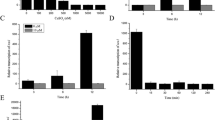Abstract
Talaromyces cellulolyticus (formerly Acremonium cellulolyticus) is one of the important strains for industrial cellulase production. An understanding of the control of cellulase gene expression in T. cellulolyticus is insufficient because only a few transcriptional factors related to cellulase gene expression have been identified. In the present study, we disrupted seven putative transcription regulator genes that showed similarity with cellulase or hemicellulase regulator genes in other filamentous fungi and investigated whether these genes are related to cellulase and xylanase production. Among the seven genes, five (tclA, tbgA, tlaA, tmcA, tclB2) had a smaller effect on cellulase and xylanase activities when culturing with cellulose. On the other hand, disruption of tacA and tctA, which are respectively homologues of ace1 (repressor of cellulase) and ctf1 (inducer of cutinase), led to a decrease in cellulase and hemicellulase production due to effects at both the enzymatic and transcriptional levels, indicating that tacA and tctA have positive roles in cellulase and xylanase production in T. cellulolyticus. These results suggest that cellulase and xylanase gene regulation in T. cellulolyticus differs from that in other filamentous fungi and imply that unknown transcriptional mechanisms function in T. cellulolyticus.




Similar content being viewed by others
References
Yamanobe, T., Mitsuishi, Y., & Takasaki, Y. (1987). Agricultural and Biological Chemistry, 51, 65–74.
Gusakov, A. V. (2011). Trends in Biotechnology, 29, 419–425.
Fujii, T., Hoshino, T., Inoue, H., & Yano, S. (2014). FEMS Microbiology Letters, 351, 32–41.
Fujii, T., Fang, X., Inoue, H., Murakami, K., & Sawayama, S. (2009). Biotechnology for Biofuels, 2, 24.
Fujii, T., Iwata, K., Murakami, K., Yano, S., & Sawayama, S. (2012). Bioscience, Biotechnology, and Biochemistry, 76, 245–249.
Inoue, H., Fujii, T., Yoshimi, M., Taylor, L. E., 2nd, Decker, S. R., Kishishita, S., Nakabayashi, M., & Ishikawa, K. (2013). Journal of Industrial Microbiology and Biotechnology, 40, 823–830.
Kanna, M., Yano, S., Inoue, H., Fujii, T., & Sawayama, S. (2011). AMB Express, 1, 15.
Stricker, A., Grosstessner-Hain, K., Würleitner, E., & Mach, R. (2006). Eukaryotic Cell, 5, 2128–2137.
van Peij, N., Gielkens, M., de Vries, R., Visser, J., & de Graaff, L. (1998). Applied and Environmental Microbiology, 64, 3615–3619.
Aro, N., Ilmen, M., Saloheimo, A., & Penttilä, M. (2003). Applied and Environmental Microbiology, 69, 56–65.
Aro, N., Saloheimo, A., Ilmen, M., & Penttilä, M. (2001). Journal of Biological Chemistry, 276, 24309–24314.
Nitta, M., Furukawa, T., Shida, Y., Mori, K., Kuhara, S., Morikawa, Y., & Ogasawara, W. (2012). Fungal Genetics and Biology, 49, 388–397.
Dowzer, C., & Kelly, J. (1989). Current Genetics, 15, 457–459.
Ilmen, M., Onnela, M. L., Klemsdal, S., Keranen, S., & Penttilä, M. (1996). Molecular and General Genetics, 253, 303–314.
Wen, Z., Liao, W., & Chen, S. (2005). Process Biochemistry, 40, 3087–3094.
Seiboth, B., Karimi, R. A., Phatale, P. A., Linke, R., Hartl, L., Sauer, D. G., Smith, K. M., Baker, S. E., Freitag, M., & Kubicek, C. P. (2012). Molecular Microbiology, 84, 1150–1164.
Yamakawa, Y., Endo, Y., Li, N., Yoshizawa, M., Aoyama, M., Watanabe, A., Kanamaru, K., Kato, M., & Kobayashi, T. (2013). Biochemical and Biophysical Research Communications, 431, 777–782.
Kunitake, E., Tani, S., Sumitani, J., & Kawaguchi, T. (2012). Applied Microbiology and Biotechnology, 97, 2017–2028.
Li, D., Sirakova, T., Rogers, L., Ettinger, W. F., & Kolattukudy, P. E. (2002). Journal of Biological Chemistry, 277, 7905–7912.
Coradetti, S. T., Craig, J. P., Xiong, Y., Shock, T., Tian, C., & Glass, N. L. (2012). Proceedings of the National Academy of Sciences of the United States of America, 109, 7397–7402.
Fujii, T., Inoue, H., & Ishikawa, K. (2013). AMB Express, 3, 73.
Fujii, T., Inoue, H., & Ishikawa, K. (2014). Bioscience, Biotechnology, and Biochemistry, 78, 1564–1567.
Fujii, T., Murakami, K., & Sawayama, S. (2010). Bioscience, Biotechnology, and Biochemistry, 74, 419–422.
Lowry, O. H., Rosebrough, N. J., Farr, A. L., & Randall, R. J. (1951). Journal of Biological Chemistry, 193, 265–275.
Fang, X., Yano, S., Inoue, H., & Sawayama, S. (2009). Journal of Bioscience and Bioengineering, 106, 115–120.
Cochet, N., Tyagi, R. D., Ghose, T. K., & Lebeault, J. M. (1984). Biotechnology Letters, 6, 155–160.
Acknowledgments
We thank Dr. Tamotsu Hoshino, Dr. Ken-ichi Nakayama, and Dr. Masahiro Watanabe of AIST for helpful discussions. This study was supported by MEXT/JSPS KAKENHI Grant Number 26850058, Japan.
Author information
Authors and Affiliations
Corresponding author
Rights and permissions
About this article
Cite this article
Fujii, T., Inoue, H. & Ishikawa, K. Decreased Cellulase and Xylanase Production in the Fungus Talaromyces cellulolyticus by Disruption of tacA and tctA Genes, Encoding Putative Zinc Finger Transcriptional Factors. Appl Biochem Biotechnol 175, 3218–3229 (2015). https://doi.org/10.1007/s12010-015-1497-2
Received:
Accepted:
Published:
Issue Date:
DOI: https://doi.org/10.1007/s12010-015-1497-2




